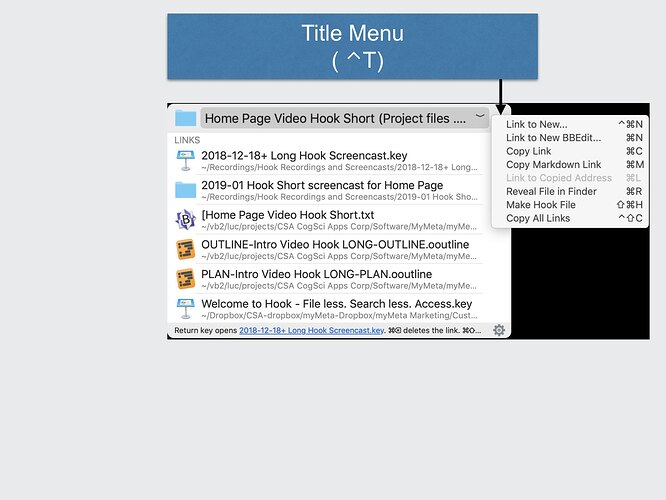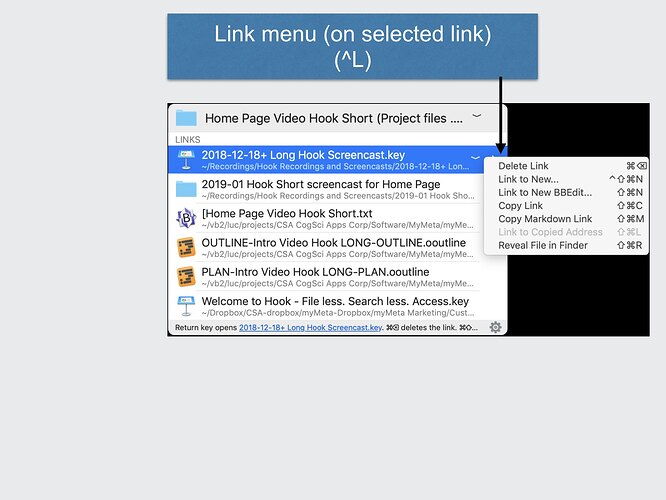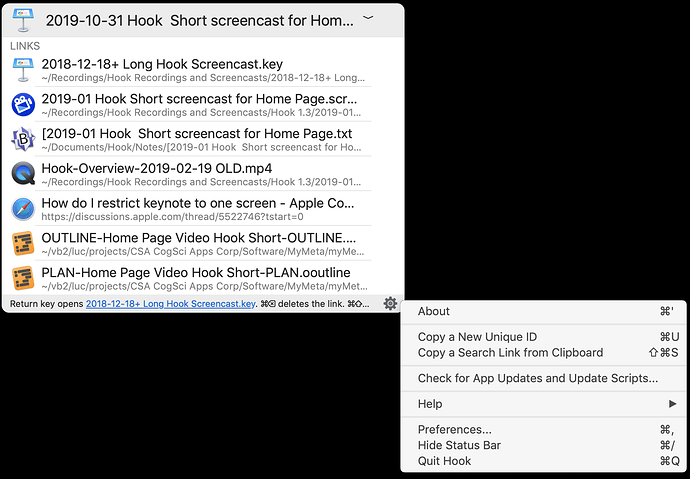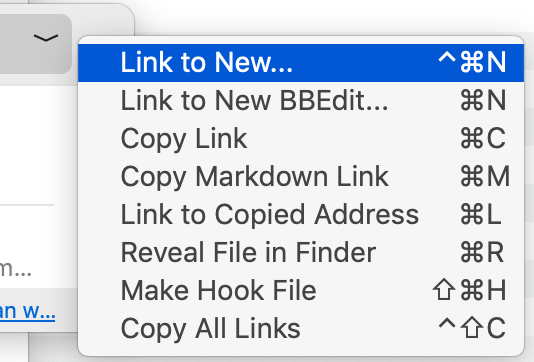We are delighted to announce major enhancements to the Hook productivity app, which you can download here or use Hook’s in-app update.
Overview of enhancements
The Hook 1.3 popup window has been significantly redesigned. It is now very compact and its operation is easy to understand.
The Hook window now has three parts as depicted and described online. They are
- the title bar, which contains a Title menu (also accessible via ⌃T) containing all the commands that operate on the current context (title item),
- the LINKS section (in the middle): each link has its own Link menu (also accessible via ⌃L), and
- the status bar at the bottom, which now contains a simpler Gear menu (also accessible via ⌃G).
Screenshots
Hook window before a resource is linked:
Hook window on a previously linked resource
note the title bar
Title Menu ( ⌃T)
Notice the links section
notice you can open linked items with ⌘1, ⌘2, etc.
You can navigate into the links as described below.
Every link has a link menu
Notice that the commands are named the same as and keyboard shortcuts super similar to the Title menu.
New location of gear menu:
And we’ve taken context-sensitive commands out of the gear menu (they’re in Title menu)
More detailed list of changes
- All commands that operate on the Title bar item (the “context”) have been consolidated into the “Title bar (
﹀) menu”. The commands include:
a. “Link to New…” ⌃⌘N : Please note the new keyboard shortcut. This menu now replaces the Hook window’s content, which is a more compact and elegant design than prior versions of Hook.
b. "Link to New<Default Note Taking app>⌘N (shortcut is available, and item will be added to the menu.) (For example, “Link to New BBEdit”)
c. “Copy Link” ⌘C
d.Copy Markdown Link⌘M
e. “Link to Copied Address” ⌘L (if a URL address is in the clipboard)
f. “Reveal File in Finder” ⌘R (if the title item is a file)
g. “Make Hook File” ⇧⌘H
h. “Copy All Links” ⇧⌃C (if there are any) - Similarly, every link now has its own Link (
﹀) menu. The Link menu is only exposed for the currently selected link (assuming there is one). Click on the﹀, or anywhere in the label, to see the menu. Or type ⌃L. Each command in the Link menu applies to the currently selected link. The Link menu commands parallel the commands in the Title menu, but they apply to the linked item. The keyboard shortcuts are the same except they involve the SHIFT key (⇧). Thanks to the Link menu, it’s extremely easy to tell what commands operate on links. - It is now possible to navigate links directly in the Hook window (without closing it)! See Navigating Links, below.
- The gear menu, which used to be the in the Title bar, is now at the bottom right of the Hook window (in the status-action bar). This is to make it very clear to new users that the Title menu is what they need to interact with at first. It also makes for a very clean, symmetric design.
- The gear menu is more compact and uniform. It no longer contains commands that apply to the Title item (the context). The gear menu now only contains global commands. The “Reveal File in Finder” and “Make Hook File” commands are now in the Title menu.
- “Check for updates” has been renamed “Check for App Updates and Update Scripts”.
- The “ACCESS LINKED ITEMS” section of Hook window is now named “LINKS”.
- There’s no longer a “CREATE AND LINK” section. All those commands have been moved to the Title menu, making it clear that they pertain to the Title item.
Navigating Links
It is now possible to navigate the network of Hook links.
- Simply type the right-arrow key or click the
>button situated on any link and you will see the links that it has. You can repeat this recursively on any link that you’ve “entered”. - Type the back-arrow key to go backwards, or click the
<button at the top left of the Title bar.
Because Hook links are bidirectional, every link has links. So you can enter any link, even links whose targets only have one link (the link back to the current item).
How it works
When you “navigate into a link” ( a.k.a. “entering” a link),
- the Title bar of the Hook window takes on the name of this link. Therefore, the Title bar menu then applies to the linked object.
- the LINKS section is then updated to contain all the links of the item you’ve “entered”.
You can recursively navigate into linked items. In other words, you can traverse the Hook link network without closing and re-opening Hook. Just right arrow into it.
As noted, to navigate outwards (back), you can touch the back arrow key  or the back button at the top left of the Title bar.
or the back button at the top left of the Title bar.
See Navigating Links (in the online documentation)
Opening a linked item (LINKS section)
The main purpose of Hook is to keep you focused by enabling you to quickly access items related to your current focus. There are several ways to activate links.
- select it and type return,
- double-click on it,
- New in Hook 1.3, and by request from the Hook forum: when you hold down the ⌘ key, Hook will display the ⌘# shortcuts you can use to access links. For instance, the first link will visibly be accessible via ⌘1, the second via ⌘2, and so on. So:
- ⌘1 opens the first linked item (if there is one)
- ⌘2 opens the second linked item
- ⌘3 opens the third linked item
- …
- ⌘9 opens the ninth linked item
Commands and keyboard shortcuts
Using keyboard shortcuts saves time, minimizes brain fatigue, and also reduces repetitive strain. Hook 1.3 offers highly enhanced keyboard shortcuts. This is clearly described in the online documentation: All Commands & Shortcuts – Hook.
Here, we’d like to emphasize:
- The fact that commands are consolidated in the Title menu, Links menus and Gear menu means it’s extremely easy to understand what commands are available and on what object each command operates (i.e., the title item, the selected linked item, or globally, respectively),
- all commands are sensibly named, keyboard shortcuts are sensibly assigned, and they are easy to memorize (should you wish),
- there are several new shortcuts, for example the new link navigation features have corresponding keyboard shortcuts, and
- Hook’s shortcuts follow macOS and emacs conventions.
So, Hook has you covered.
Bug fixes
The following 1.2.2 issues are fixed in 1.3
- some rare crashes.
- Fixed an issue that prevented Hook menu bar icon from linking a Bear note to another object.
- Previously, too many characters of a link name in LINKED ITEMS section were displayed
- Fixed apparent link asymmetry for URLs containing an ampersand .
- FIXED error in Preferences
>Scripts>Address tab regarding file:\[path to the file]
Updated Integration scripts
- There is now a Margin Note script, from the forum.
- Scripts updated for Catalina Notes.app. See this web page.
- Scripts updated for Xcode 11
Gratitude
Thank you to everyone who contributed on Hook Forum or other channels.








